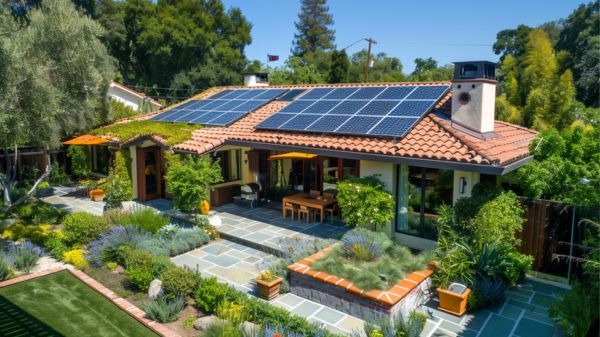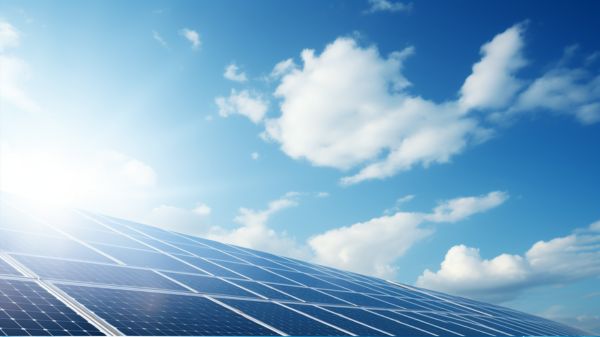You may wonder about the practicality of hydroelectric energy technology in today’s rapidly evolving energy landscape, but consider this: the benefits it offers are not just numerous but also essential for a sustainable future.
From providing clean and reliable energy to fostering job creation and economic growth, hydroelectric power has much to offer. So, why not explore the top 10 advantages it brings to the table and see how it might shape our energy outlook for years to come?
Key Takeaways
- Renewable energy source with minimal greenhouse gas emissions.
- Enhances energy security and grid stability.
- Supports flood control and irrigation needs.
- Provides recreational opportunities and economic growth.
- Contributes to job creation and rural development.
Renewable Energy Source
Hydroelectric energy stands as a prominent renewable source in the modern era, utilizing the force of flowing water to generate electricity. Hydropower plants play an important role in the renewable energy sector, offering a clean and sustainable alternative to traditional fossil fuel-based power generation. These plants operate by converting the kinetic energy of water into electrical energy, without releasing harmful greenhouse gas emissions into the atmosphere.
The beauty of hydropower lies in its reliance on the natural water cycle, making it a consistent and reliable energy source. Unlike non-renewable sources like coal or oil, hydropower offers a greener solution that helps reduce our dependence on fossil fuels. By integrating hydroelectric energy into the energy mix, countries can enhance their energy security while promoting environmental sustainability.
Hydropower plants not only contribute to a cleaner environment but also pave the way for a more diversified and resilient energy grid. Embracing this renewable energy source can lead to a brighter, more sustainable future for generations to come.
Clean Energy Production
Clean energy production through hydroelectric technology is a pivotal component of the global electricity supply, offering a sustainable alternative with minimal greenhouse gas emissions.
Hydroelectric power plants are a key player in clean energy, accounting for approximately 16% of the world’s electricity generation. This significant contribution to renewable energy helps reduce the carbon footprint of the power sector.
The longevity of hydroelectric plants, which can operate for 50-100 years, provides a stable and sustainable energy source for the long term.
One of the notable advantages of hydroelectric energy production is its operational flexibility. Hydroelectric plants can quickly adjust their output to meet fluctuating electricity demand, making them a reliable source of clean energy that complements other intermittent renewable sources like solar and wind power.
Domestic Energy Independence
Utilizing domestic energy sources enhances a country’s independence from international fuel imports and strengthens its energy security.
Hydroelectric energy stands out as an essential domestic energy source, harnessing the power of water to generate electricity. By relying on hydropower, nations reduce their dependence on foreign energy supplies, mitigating the risks associated with fluctuating global energy markets.
This shift towards domestic energy sources not only bolsters energy independence but also plays a pivotal role in enhancing national security. Countries that invest in hydropower technology gain more control over their energy production, decreasing vulnerabilities to geopolitical tensions and ensuring a stable energy supply.
Additionally, domestic hydropower production fosters resilience in the face of global energy uncertainties, providing a reliable and sustainable source of energy.
Embracing hydroelectric energy not only promotes energy self-sufficiency but also contributes to the overall stability and security of a nation’s energy infrastructure.
Recreational Opportunities Offered
Hydropower reservoirs present various recreational opportunities for individuals seeking outdoor activities. Boating, fishing, and swimming are popular pastimes made available by the creation of these reservoirs.
The presence of recreational areas around hydropower facilities not only attracts tourists but also supports the economic growth of local communities.
Recreational Activities Availability
Recreational activities at hydropower sites attract visitors seeking diverse outdoor experiences and leisure opportunities. The availability of recreational activities enhances the overall appeal of hydropower locations, offering a range of options for visitors to engage with the natural environment and enjoy leisure pursuits.
Here are four key recreational opportunities offered at hydropower sites:
- Boating: Hydropower reservoirs provide ample space for boating enthusiasts to explore the water, whether through motorized boats or kayaks.
- Fishing: The calm waters of hydropower reservoirs are ideal for fishing, attracting anglers looking to reel in various fish species.
- Camping and Hiking: The scenic views and tranquil surroundings near hydropower sites create perfect settings for camping under the stars and going on hiking adventures.
- Water Sports: Thrill-seekers can enjoy activities like kayaking, paddleboarding, and water skiing in the reservoirs, adding an element of excitement to their recreational experiences.
Reservoir-Based Leisure Opportunities
The reservoirs created by hydropower projects serve as hubs for a variety of recreational activities, attracting visitors and enhancing local tourism. These reservoirs offer a wide range of leisure opportunities, including boating, fishing, and swimming.
The scenic landscapes surrounding these reservoirs provide outdoor enthusiasts with a beautiful backdrop for their adventures. Additionally, water-based recreational activities in these reservoirs play a significant role in the economic development of nearby communities by drawing in tourists and boosting local businesses.
Furthermore, hydropower reservoirs aren’t limited to just water activities. They also cater to individuals interested in water sports, wildlife viewing, and camping, making them versatile destinations for a diverse range of visitors.
The development of reservoirs for hydropower generation not only provides clean energy but also supports conservation efforts and environmental education programs, creating a sustainable balance between energy production and recreational enjoyment.
Flexibility in Power Generation
Flexibility in power generation is a key advantage offered by hydroelectric energy technology, allowing for efficient adjustment of output to meet varying electricity demands. Here are four ways in which this flexibility benefits the energy source:
- Essential Energy Production: Hydroelectric plants can swiftly adapt their generation levels to match fluctuations in energy needs, ensuring a reliable power supply during peak demand periods.
- Grid Resilience: The ability to store water in reservoirs enables hydroelectric facilities to provide backup power in case of grid outages, contributing to grid resilience and reducing the risk of blackouts.
- Complementary Role: By seamlessly integrating with other renewable energy sources like wind and solar, hydroelectric energy fills in gaps in power generation when these sources are less predictable, promoting a more stable and sustainable energy mix.
- Key Role in Grid Stability: The flexibility of hydroelectric energy technology plays an important role in supporting grid stability by balancing the electricity supply and demand, contributing to a more efficient and reliable power system.
Flood Control and Irrigation Support
Hydroelectric energy technology provides effective water management solutions through flood control measures and regulated irrigation support.
By manipulating water levels in reservoirs, hydropower systems guarantee a steady water supply for agriculture, assisting in crop production and food security.
The capacity to prevent floods and offer irrigation opportunities highlights the valuable role of hydropower in safeguarding ecosystems and sustaining communities.
Water Management Solutions
Effective water management through hydroelectric energy technology involves regulating water flow to prevent floods and provide reliable irrigation support for agricultural activities. The production of electricity through hydroelectric dams facilitates the controlled release of water, ensuring a balanced ecosystem and sustainable water usage.
Here are four key aspects of how hydroelectric energy technology contributes to efficient water management:
- Storage Capacity: Hydroelectric reservoirs have the ability to store excess water, preventing sudden flooding and ensuring a steady water supply for irrigation purposes.
- Flood Prevention: By strategically releasing water during heavy rainfall or flood-prone periods, hydroelectric dams help prevent catastrophic flooding in downstream areas.
- Irrigation Support: Controlled water release from reservoirs supports agricultural activities by providing a consistent water supply for crops, enhancing yields and promoting sustainable farming practices.
- Sustainable Resource Management: Hydroelectric energy technology aids in maintaining a delicate balance between water availability and the diverse needs of agriculture, urban areas, and ecosystems, ensuring long-term water resource sustainability.
Agricultural Support Systems
Agricultural resilience in the face of natural challenges is greatly bolstered by the flood control and irrigation support systems provided by hydroelectric energy technology. These systems are integral to safeguarding agricultural lands and crops against the devastating impact of floods. By regulating water flow, hydroelectric energy technology helps prevent floods, ensuring the protection of essential agricultural areas.
Additionally, the reliable water supply facilitated by these systems plays a crucial role in enhancing agricultural productivity and sustainability through efficient irrigation practices. Hydropower plants, as part of water management systems, contribute greatly to supporting farmers and communities in managing water resources effectively.
The agricultural support systems of hydroelectric energy technology are essential pillars in ensuring food security and fostering rural development, highlighting the indispensable role this technology plays in sustaining agricultural activities and livelihoods.
Flood Prevention Strategies
Implementing resilient flood prevention strategies is essential for maintaining water flow regulation and safeguarding agricultural lands against potential flood risks. Hydroelectric power plants play an important role in flood control and irrigation support, providing a range of benefits:
- Water Flow Management: Hydroelectric energy technology plays a vital role in controlling water flow, reducing the risk of flooding in downstream areas.
- Irrigation System Support: By regulating water levels, hydropower plants guarantee consistent access to water for agricultural irrigation, promoting crop growth.
- Drought Mitigation: Hydropower facilities can release water during dry periods to support irrigation needs, alleviating the impact of droughts on agricultural production.
- Community Protection: Flood prevention strategies implemented by hydroelectric projects help protect communities, agriculture, and infrastructure from water-related disasters, enhancing overall resilience.
Through these flood prevention strategies, hydroelectric power plants contribute significantly to sustainable water management practices, benefiting both agricultural activities and community safety.
Affordability and Durability
Hydropower technology stands out as an essential and durable energy solution with low operating costs and a lifespan averaging 50 to 100 years. The mechanical energy harnessed from flowing water enables hydropower plants to generate electricity efficiently, with minimal environmental impact.
This sustainable energy source offers a reliable investment opportunity due to the durability of hydropower plants, ensuring long-term energy production.
Hydroelectric developments not only provide cost-effective solutions for clean power generation but also offer significant storage capacity, enhancing grid stability. The importance of hydropower plays a key role in stabilizing energy prices and reducing dependence on fossil fuels, thereby contributing to a more sustainable energy mix.
With low maintenance and operational costs, hydropower projects yield long-term economic benefits and enhance energy security, making them a viable option for countries seeking reliable and durable energy solutions.
Job Creation and Growth
With a current workforce of 66,500 employees in the U.S., the hydropower industry is poised for substantial job growth, projecting to reach 120,000 by 2030 and 158,000 by 2050.
Here are some reasons why job creation in the hydropower industry is essential:
- Diverse Opportunities: From manufacturing to utilities and construction, the hydropower industry offers a wide range of job opportunities, catering to various skill sets and interests.
- Rural Economic Boost: Job creation in rural areas not only provides employment but also stimulates local economies, fostering sustainable growth and stability.
- Education Programs: Nationwide hydropower education programs equip individuals with the necessary training and skills, ensuring a qualified workforce to meet industry demands.
- Economic Development: The established hydropower industry serves as a robust foundation for job growth, driving economic development across sectors and regions.
The growth of the hydropower industry signifies not only an increase in employment opportunities but also a positive impact on local communities and the economy at large.
Operational Flexibility and Investment
The vital operational flexibility and long-term investment benefits of hydroelectric technology make it a strategic choice for meeting electricity demand fluctuations and supporting sustainable development initiatives.
Hydroelectric plants offer the operational flexibility needed to respond swiftly to varying electricity demands and complement intermittent renewable energy sources effectively.
With an impressive lifespan of 50 to 100 years, hydroelectric developments present a durable investment option with minimal operating costs for future upgrades. This longevity guarantees stable power generation over time, contributing to energy stability and aiding in the integration of diverse renewable energy sources.
Moreover, the efficiency and storage capacity of hydroelectricity play an important role in sustainable development, meeting current needs without compromising those of future generations.
Investing in hydroelectric technology not only guarantees reliable power generation but also proves cost-effective and provides the added benefit of storing drinking water for communities, making it a wise and forward-thinking choice for long-term energy solutions.
Environmental and Economic Benefits
Environmental and economic benefits are key aspects of hydroelectric energy technology, highlighting its substantial contributions to sustainability and prosperity.
Hydroelectric energy stands out for its positive impact on the environment and the economy, making it a valuable asset in the pursuit of a greener and more prosperous future.
Here are four essential points worth noting:
- Reduced Greenhouse Gas Emissions: Hydroelectric energy notably decreases greenhouse gas emissions, aiding in the fight against climate change and promoting cleaner air quality.
- Toxic By-Product Elimination: Unlike other energy sources, hydroelectricity doesn’t produce toxic by-products, safeguarding water tables and reducing the risk of floods and droughts.
- Economic Development: Hydroelectric installations foster economic growth by providing jobs and improving access to healthcare and education in surrounding communities.
- Enhanced Quality of Life: By offering sustainable, clean, and affordable energy, hydroelectric technology enhances the quality of life for current and future generations, promoting long-term well-being.
Conclusion
To sum up, the top 10 benefits of hydroelectric energy technology showcase its pivotal role in shaping a sustainable energy future. From its renewable and clean energy production to its economic and environmental advantages, hydroelectric power stands as a powerhouse in the energy sector.
With its ability to provide domestic energy independence, job creation, and operational flexibility, the potential for growth and innovation in this field is limitless.
Embrace the power of hydroelectric energy for a brighter, greener tomorrow.




